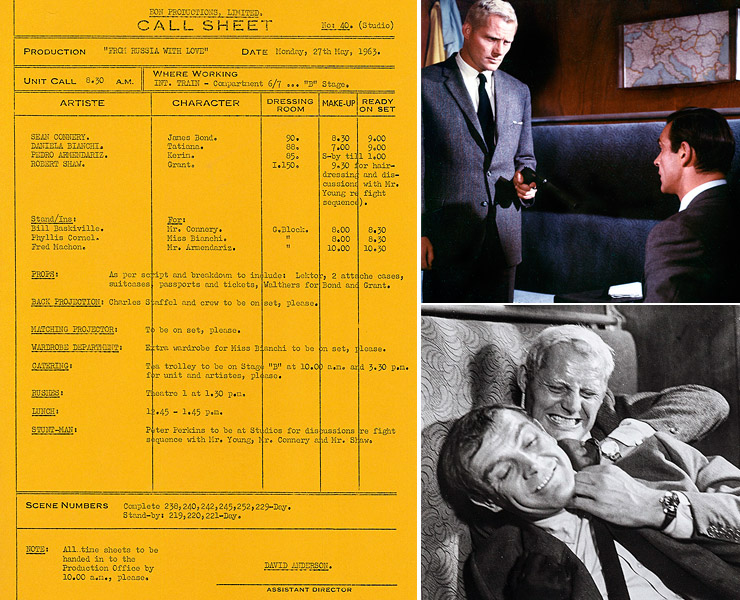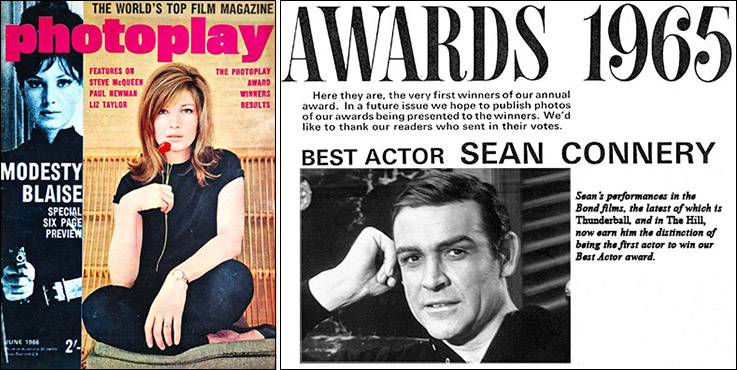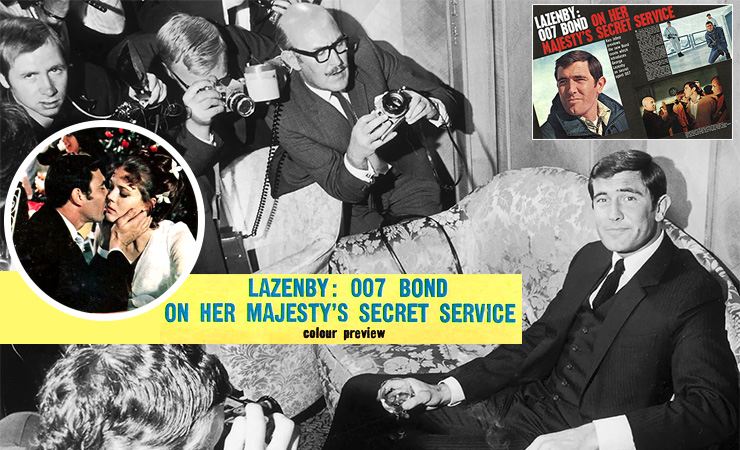|
EXCLUSIVE ARTICLE |
||
|
||
|
EXCLUSIVE ARTICLE |
||
|
||
|
|
|
|||||||
|
July 21, 1989 He was then living in a mews flat off London’s Hampstead Lane. It was almost noon. “Fancy breakfast?” he asked. I had to come to interview the then almost unknown Mr. Connery for a series of articles about Britain’s young acting hopefuls. My subsequent published piece in the April 1958 issue of PHOTOPLAY [cover and first page of the feature article ‘What a hunk of he-man’ pictured below] was one of the first magazine features about Sean. At that time the role of James Bond wasn’t even on the immediate horizon. He was building his reputation in other films. |
|||||||
|
|||||||
|
The next time we met was a few years later. This time in the more plush, elegant surroundings of the Dorchester Hotel in Park Lane. This was to be Sean’s big day. The day he was “launched” to the world’s press as James Bond in Dr. No. His first major step on to the James Bond bandwagon. When the conference was over Sean and I stepped out into Park Lane. Nobody recognised him. No fans waiting. Nobody asked for his autograph. I recall saying to him, “Things are going to really change for now, Sean.” He gave me a quizzical look. “What do you mean?” he asked. “Well, now you are Bond, which will make you a big, big star. Your private life won’t be your own after you’ve made this movie!” I said. Sean smiled. “You think so? Don’t you believe it. This won’t happen to me. And I’m certainly not going to be type-cast as Bond, believe me,” he said as we said goodbye with a shake of hands. Next time I saw Sean he was up there on screen pretending to be 007 in Dr. No. He looked good. He was good! There were only about a dozen of us for this private screening in one of those tiny private viewing theatres. This one situated only a few yards away from the Dorchester Hotel. In stark contrast to a media screening of a Bond movie today, this was a very quiet affair. After all, this was just another movie, just another screening. Little did we realise then that 27 years later, Bond films would still be made! Naturally I’ve watched Sean’s progress with much interest since the day in 1957, having predicted he would become one of our top actors – all those years ago! “Jeez,” he said when we last met at his press conference for The Name Of The Rose (1986), “we do go back a long way!” |
|||||||
|
|||||||
|
Over the years I’ve visited many Bond sets at Pinewood. On From Russia With Love (1963) I was chatting to Lotte Lenya (who played the vicious Rosa Klebb) and Robert Shaw (who was Red Grant) in the studio’s beautiful gardens, when Sean suddenly came over to me. “Fancy seeing some film?” he asked as I was about to go off for a drink and lunch with Mr. Shaw, sadly no longer with us. “What sort of film?”
I asked him. We made our way to the viewing theatre. Sat down. The lights were dimmed. ‘Rushes’ in case you didn’t know, is raw, unedited footage, just as the director shot it. On to the screen appeared Sean and Robert Shaw involved in their titanic struggle on the ‘Orient Express’ – locked together in combat inside a tiny compartment. Take followed take. Sean then nudged me. “Watch this one,” he said with a slight laugh in his voice. “I want you to see this!” |
|||||||
 |
|||||||
|
On came the same scene again. But this time, an unexpected moment. The compartment was suddenly opened by a man dressed up to look exactly like Robert Shaw as Red Grant. “’Ere,” said the intruder. “What are you doing to my brother?” Sean and Shaw, with astonished looks on their faces, stopped fighting and turned to the door. That ‘brother’ line was certainly not in the script. Suddenly I could hear – on the soundtrack – the whole crew laughing. It was only then that the two actors realised it had all been a well-planned joke. “Good eh?” laughed Sean sitting next to me. “That’s what I wanted you to see.” Goodness knows how many of these funny ‘out takes’ could be laying around somewhere. |
|||||||
 |
|||||||
|
Another occasion I well remember at Pinewood was the time I went there to present Sean with one of his first awards. He had been voted by PHOTOPLAY readers as the ‘Best Actor of The Year’. This was back in 1965 [announced in the June 1966 issue pictured above]. His prize was a special Gold Medal… THE PHOTOPLAY AWARD! There was nothing formal about the presentation ceremony. In fact it took place outside one of Pinewood’s stages. Just Sean, me and a photographer. I had noticed, as Sean walked over to us, that he was without his famous Bond hairpiece. He had also grown a moustache. He looked nothing like the screen’s Bond. No way. Sean seemed to be in a hurry. “Where do you want me to stand?” he asked the photographer as I prepared to hand over the Gold Medal. “Errr…” I hesitated pointing to Sean’s head. What about the – errr!” After all, he was about to be photographed minus an important part of his Bond persona. “Oh, don’t worry about that,” he said, and duly posed for the ‘handing-over’ of the award. A case of “toupee, or not toupee” but, oddly enough, the photo was never published. |
|||||||
 |
|||||||
|
I have long admired Connery as an actor and was justly pleased – no, proud – when he finally got his rewards with a British and American Oscar. For years his talent went unrecognised. He almost certainly stayed with the Bond character for far longer than he had anticipated, or even expected. George Lazenby, Sean’s immediate successor, had a very brief fling. From the media attention Lazenby received he didn’t emerge in a very likeable light. In fact, I heard on the radio only the other day a critic say that he considered On Her Majesty’s Secret Service (1969) to be one of the “best” and “purest” Bond films of them all. Surprising perhaps, but a sort of tribute to Lazenby’s one performance as Mr. Bond. When I visited the OHMSS set to meet with Lazenby I arrived expecting to find Mr. L difficult to deal with, having read the publicity which had appeared in some national newspapers. None of the suggested conceit or arrogance was at all noticeable in our one-hour meeting. In fact, George took particular delight in telling a story against himself. “When I turned up for my first day’s work here at Pinewood the man on the gate wouldn’t let me in. He didn’t know who I was! When I told him I was the new James Bond he didn’t believe me. He had to phone through to someone to get confirmation that this fella named George Lazenby was playing James Bond,” he said. |
|||||||
|
|||||||
|
By the time Live And Let Die (1973) came around we had yet another Bond – Roger Moore – destined for another long run. For years he had been The Saint. In fact, I first met Roger when I went along with him to a Savile Row tailor where he had his suits made for the role of Simon Templar. Perhaps Roger was closer to Ian Fleming’s literary creation of Bond than Sean or Lazenby, but Sean really set the mould. The more lightweight Roger brought his own comedy style to the role. He and producer ‘Cubby’ Broccoli enjoyed endless games of backgammon on their Bond movies together. When I went on to the set of For Your Eyes Only (1981), Roger had found another playing partner – Topol. I sat with them during one game until Roger was called on to the “monastery” set. “Take over for me, will you?” he asked me. “Can you play?” asked Topol. I said I couldn’t. When Roger returned he asked, “Well, how much did I win?” But since then I’ve learned how to play the game but would never dare try my hand against Roger – one of the coolest backgammon players around. After all, playing Bond, he’s had plenty of practice. |
|||||||
|
|||||||
|
A Bond movie set with Roger on it was generally a fun place to be. The atmosphere was usually relaxed. It’s the way Roger likes to work. I remember the day I visited the angled set constructed to give the impression of a tilted ‘Queen Elizabeth’ liner in Hong Kong harbour. It was for The Man With The Golden Gun (1974). Naval Intelligence used it as their base. I was in the middle of doing an interview with Roger when he suddenly walked over to where a non-serviceable loo had been constructed. Roger stood over it, then said, “Have you ever wondered how difficult it is to pee in a loo on a tilting ship?” I must say I hadn’t! “Think about it,” smiled Roger. I could see what he was getting at! On The Spy Who Loved Me (1977) one day, I noticed Roger was scribbling something in a notebook as we chatted. Then he showed me what he’d been doing. He had drawn a caricature of me. “Give me a couple of numbers,” he said. Within a few minutes he had turned the two numbers into a cartoon showing a footballer kicking the referee who was taking his name. Then Roger signed his own name which he then turned into a cowboy wearing a Stetson. He is quite an accomplished cartoonist. I thought I would give him a challenge. “Draw a caricature of yourself as James Bond,” I said. He thought for a moment. “Okay,” he said, and within a minute he produced an interesting result by drawing the familiar Bond pose with gun in hand. But I noticed something unusual. Roger had parted his hair on the wrong side. He had drawn the image he sees when he looks into a mirror – the way he sees himself. In reverse! “Interesting,” Roger remarked. Now we have yet another actor as Bond – Timothy Dalton, who brings to the role a much deeper intensity than any of his three predecessors. Propping up the Pinewood bar with him one lunchtime I found Dalton to be the most difficult of the three to get to know. He’s more guarded in his responses. Less inclined to joke about, and it shows on screen. He doesn’t look at all comfortable with the one-liners, started by Sean and elaborated by Roger. But at least in Licence To Kill (1989), Dalton is looser than he was in The Living Daylights (1987). He certainly enjoyed himself far more while making his second 007 movie than he did the first. It’s always difficult being “the new boy” trying to stamp his own individuality in an attempt to make us forget Connery, Lazenby and Moore. |
|||||||
|
|||||||
|
But I’ve a sneaking suspicion creator Ian Fleming himself might have approved of Mr. Dalton as James Bond. Fleming was certainly surprised by the choice of Sean Connery in Dr. No (1962). Indeed, he told me so himself when I once talked to him in his office in London’s Inner Temple. I was just as surprised to find Fleming working in an area much better known for its number of judges, barristers, and lawyers. I noticed the walls of his office were decorated by very sexy covers of his Bond novels, printed in all languages. Why had he invented James Bond? “I needed something to take my mind off my forthcoming marriage,” he said quietly. The suave originator of Mr. Bond (now played by Charles Dance in a TV production, Goldeneye) said he had based his first Bond story, CASINO ROYALE, partly on one of his own experiences in intelligence. The only difference being that when Ian Fleming sat at the table he lost. Bond had to win of course. And he’s certainly been a winner for the likes of Sean Connery, George Lazenby, Roger Moore – and now Timothy Dalton. A winner indeed for us all. A screen hero for the last 27 years – a movie institution that goes on and on and on… And for me – a lot of happy memories of trips to Pinewood Studios during those years, and encounters with four very different James Bonds! |
|||||||
|
|
|||||||
 |
|||||||
|
|||||||
|
Sadly, there is very little background information to be found on either Sylvia or Ken Ferguson, whose life and careers were devoted to film. Ken began his journalistic career after leaving school when he worked on the magazine Opera, founded in 1950 by the late Lord Harewood [George Henry Hubert Lascelles, 7th Earl of Harewood, KBE, AM (1923-2011)]. Ken became feature writer (and later editor) on PHOTOPLAY from the mid-1950s, until its demise in 1989. Ken Ferguson married Sylvia Simmons (a freelance entertainment journalist) at the Acton Congregational Church on Saturday March 10, 1962, where his Best Man was Scottish actor Gordon Jackson (1923-1990). Ken was also a keen supporter of local filmmakers and a prize-winning member of the Staines Cine Society. Through the pages of PHOTOPLAY cinemagoers were treated to unique behind-the-scenes interviews and previews of forthcoming big films, with attractive photo spreads and star gossip. The December 1979 issue of PHOTOPLAY [pictured above] was one of the first publications to report on Sean Connery's potential comeback as James Bond; and in his editorial column Ken also recounted his many other major star encounters, with a rare photograph showing his meeting with Sigourney Weaver. Film Show annual was published by Purnell throughout the 1950s and early 1960s, and Sylvia & Ken Ferguson supplied the editorial, with the images coming from their extensive PHOTOPLAY picture archive. Sean Connery appeared on the cover of the 1963 annual, with a double-page background feature inside that also featured interviews and profiles of current film stars. In the 1970s and 1980s Ken Ferguson also edited the PHOTOPLAY FILM ANNUAL (later YEAR BOOK) which had articles and features on the Roger Moore James Bond films. |
|||||||
| JAMES BOND NEWS | |||||||